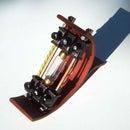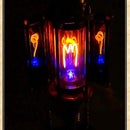Introduction: Steampunk Punch Clock
Hi everybody!
After building the UV-Fluorescence-Steampunk-Lamp I experienced -while I presented this apparatus at the maker faire Ruhr, Dortmund 2017, that nearly everyone switched on the lamp, took some photos an went away without switching off. So the High Powered UV-LED´s started to heat up and that´s not good. So I needed to create this Steampunk Punch Clock as a time-switch . And at least „I did it my way“ ;-))
Just
push down down the plunger which starts the mechanic of the adjustable clockwork. While the clockwork is running, a connector closes a wire gap and opens when time is over. Additional, the clockwork is illuminated by three amber colored LED and one signal light which consists of an uranium glass marble and a „blacklight“ UV-LED (405 nm) shines too (see alsoSteampunked Magic-Uranium-Light).
This punch-clock-switch will be supplied with an external DC-plug (5,0 Volts, 2A) for normal use at exhibitions or you can test its light functions with three AA-batteries (4,5 Volt) which are integrated in this object.
Now let me show you first a small „movie“ about this switch working
and here comes the instructable explained in its well known detailed way!
Hope you enjoy it
Yours Aeon Junophor.
Step 1: The Clockwork "Heart"
Two years ago I got the chance to discover a steampunk treasure when I helped to clear up an old mechanical workshop which already had been closed for more than five decades.
In a dark corner stood an old wooden box with some of these very old punch clock timers used around 1920/1930 in former photo-laboratories- They were started by activating a giant solenoid, Everything was thickly covered with dust.
Some clocks had too much damages, but one clock was working best after a careful cleaning.
The clockface is enameled, the clockwork consists mainly of brass made gears and some springs made of steel. You can also choose between a „running fast“ or „running slow“ mode.
The former insulating screw joints had been fixed at a thick plate of hard paper at the back.
So the idea came to my mind to reactivate this wonderful clockwork and construct an impressing and sumptuous steampunked time switch.
This short animated sequence shows the original clock and my first attempt.
It was my aim to use as much original parts as possible.
Step 2: Plywood Base
A plywood base follows in form and dimensions the base of the UV-Fluorescence-Steampunk-Lamp. It contains the battery holder for the 3 AA batteries and has enough space to keep the whole length of the extension cord.
The wooden parts had been colored with some „antique-wax“ liquid and were lightly polished when dried.
Step 3: Designing the Pusher
I wanted to start the „new timer“ by hand with pushing down the plunger of the former electromagnet – So I unscrewed the solenoid and changed it with a brass made blower of an old kerosene lamp. It was fixed by soldering, gluing and screwing together with different parts from plumber scrap.
The he iron pusher was covered with a brass nipple ¾ inch and a coppermade washer on top.
Step 4: Capping the Clockwork
To protect the clockwork a covering hood was needed. I chose a piece of punched copper plate (also from srap) so everyone could watch the different gears working.
To illuminate this clockwork while running, three amber-colored LED´s had been covered in brassmade Edison screw sockets E10 and integrated in the hood. To supply these LED´s with ectricity three strong picees of spiral formed copper wire had been soldered to the base contact of the screw sockets and led to the terminal strip. The new hood works as the other contact to close the circuit.
Like all brass and copper parts this plate had been polished and covered with zapon laquer too.
The new rear panel was made out of the excisting hard paper plate. As a step in between I used a plate of acrylc glass to prepare a model.
Next I had to fix the copper hood with the front- and rear panel by brassmade screws.
Connectors/bridges from electrical junction plates -made of brass and nicely formed- work best as you can see. First I fixed them to the copper hood with screws and nuts (4 mm), then I bended them around to the clockface and finally got in that way the right position for drilling the new screwholes (also 4 mm) there.
Because of another bad experience that many people tried to change the switching time by turning the pointer without asking, I also had to fix the hand with a piece of thick brass wire.
Now the clock runs for about 25 seconds „one steampunk time-inch“ when started, and that gives the observers enough time to take some photos of the illuminated punch clock itself and of the famous UV-Fluorescence-Steampunk-Lamp, or just for watching the clockwork running.
The clock timer can be started again as often as wanted.
Step 5: The Uranium Glass Signal Light
As a special „highlight“ and to harmonize the design I had to build up a fanciful construction of copper tubes and brass parts at the backside of the timer. All parts had been taken again out of the scrap of my local plumber and were just polished and covered with zapon laquer. All parts fitted well enough to be soldered together, glued with epoxy resin or had bee screwed together.
The top is crowned with a magic uranium light-bulb which shines bright, while the clockwork is ticking and running. The bulb holder is constructed of another brassmade blower from an old kerosene lamp. The construction of the bulb with an uranium glass marble and the UV-LED follows straight the steps of my instructable projekt Steampunked Magic-Uranium-Light.
Step 6: Electrical Equipment
A new build in receptacle for coaxial DC-power connectors (Type A: 5.5 mm OD, 2.1 mm ID, IEC 60130-10:1971) at the backside is used as entrance for an external DC-power supply, then the new time-switch follows with all four LED lights and a plug (same size and combined with an extension cord of 5,80 meters ) leads the way out to other electrical users like the famous UV-Fluorescence-Steampunk-Lamp, see following schematic.
The whole cord can be shoved in a void of the wooden base. Another switch besides the connector entrance is used for testing or showing the light of this apparatus without using an external DC-power supply. The AA-batteries supply this switching circuit. In this mode the 4.5 Volts from the batteries also can be taken with the extension cord for testing other objects.
Also the position of the switch lever shows which circuit is active at present.
I hope you enjoyed this project and if you like vote for it it would be a pleasure to me
Yours Aeon Junophor

Participated in the
Make it Glow Contest 2018













